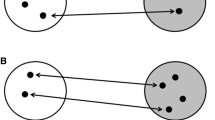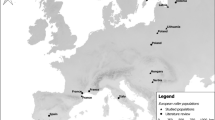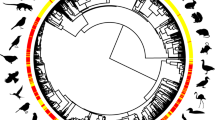Abstract
Variation in migratory behaviour among birds is thought to reflect the relative variability in abundance of resources used by different species. Here I present evidence that increased migrancy among North American passerines is associated with greater reliance on food resources that vary in abundance because they occur in microhabitats that are exposed both to consumers and environmental fluctuation, and that residency is associated with use of food resources that occur in more ‘buffered’ microhabitats, and so are relatively invariant in abundance. Evidence from a variety of sources suggests that migrants and residents also differ in their use of foraging actions and methods of exploring the environment, with migrants using a rapid, extensive method of exploration, and a plastic, opportunistic foraging mode, while residents explore more methodically and use more stereotyped foraging actions. This suggests that the degree of migrancy exhibited by a species may be part of a suite of coadaptations for exploitation of foraging microhabitats at a particular position on the buffering scale, and I propose a selective typology involving feedback loops that could generate such coevolution. I also explain established patterns of difference between migrants and residents in morphology, and in resource use and distribution, as outcomes of the evolutionary scenario described.




Similar content being viewed by others
References
American Ornithologists’ Union (1998) Checklist of North American Birds, 7th edn. Allen Press, Kansas
Askins RA (1983) Foraging ecology of temperate-zone and tropical woodpeckers. Ecology 64:945–956
Atkinson EC, Cade TJ (1993) Winter foraging and diet composition of Northern Shrikes in Idaho. Condor 95:528–535
Barker FD, Cibois A, Schikler P, Feinstein J, Cracraft J (2004) Phylogeny and diversification of the largest avian radiation. Proc Natl Acad Sci USA 101:11040–11045
Bell CP (2000) Process in the evolution of bird migration and pattern in avian ecogeography. J Avian Biol 31:258–265
Bell CP (2005) The origin and development of bird migration: comments on Rappole and Jones, and an alternative evolutionary model. Ardea 93:115–123
Bohning-Gaese K (2005) Influence of migrants on temperate bird communities a macroecological approach. In: Greenberg R, Marra PP (eds) Birds of two worlds: the ecology and evolution of migratory birds. Johns Hopkins University Press, Baltimore, pp 143–153
Boyle WA, Conway CJ (2007) Why migrate? A test of the evolutionary precursor hypothesis. Am Nat 169:344–359
Chesser RT (1998) Further perspective on the breeding distribution of migratory birds: South American austral migrant flycatchers. J Anim Ecol 67:69–77
Chesser RT, Levey DJ (1998) Austral migrants and the evolution of migration in New World birds: diet, habitat and migration revisited. Am Nat 152:311–319
Cotgreave P (1994) Migration, body-size and abundance in bird communities. Ibis 136:493–496
DeGraaf RM, Tilghman NG, Anderson SH (1985) Foraging guilds of North American Birds. Environ Manag 9:493–536
Dunn JL, Alderfer JK, Lehman PE (1999) Field guide to the birds of North America. National Geographic Society, Washington, DC
Fager EW (1968) The community of invertebrates in decaying oak wood. J Anim Ecol 37:121–142
Felsenstein J (1985) Phylogenies and the comparative method. Am Nat 125:1–15
Fuller RJ, Crick HPQ (1992) Broad-scale patterns in geographical and habitat distribution of migrant and resident passerines in Britain and Ireland. Ibis 134(suppl 1):14–20
Garland T, Harvey PH, Ives AR (1992) Procedures for the analysis of comparative data using phylogenetically independent contrasts. Syst Biol 41:18–32
Grafen A (1989) The phylogenetic regression. Phil Trans R Soc Lond B 326:119–158
Harvey PH, Pagel MD (1991) The comparative method in evolutionary biology. Oxford University Press, Oxford
Herrera CM (1978a) On the breeding distribution pattern of European migrant birds: MacArthur’s theme re-examined. Auk 95:496–509
Herrera CM (1978b) Ecological correlates of residence and non-residence in a Mediterranean passerine bird community. J Anim Ecol 47:871–890
Hockey PAR (2000) Patterns and correlates of bird migrations in sub-Saharan Africa. Emu 100:410–417
Hockey PAR (2005) Predicting migratory behavior in landbirds. In: Greenberg R, Marra PP (eds) Birds of two worlds: the ecology and evolution of migratory birds. Johns Hopkins University Press, Baltimore, pp 53–62
Jønsson KA, Fjeldså J (2006) A phylogenetic supertree of oscine passerine birds (Aves: Passeri). Zool Scr 35:149–186
Karr JR (1976a) On the relative abundance of migrants from the north temperate zone in tropical habitats. Wilson Bull 88:433–458
Karr JR (1976b) Seasonality, resource availability, and community diversity in tropical bird communities. Am Nat 110:973–994
Lack PC (1986) Ecological correlates of migrants and residents in a tropical African savanna. Ardea 74:111–119
Levey DJ, Stiles FG (1992) Evolutionary precursors of long-distance migration: resource availability and movement patterns in Neotropical landbirds. Am Nat 140:447–476
MacArthur RH (1959) On the breeding distribution patterns of North American migrant birds. Auk 76:318–325
MacArthur RH (1972) Geographical ecology. Harper & Row, New York
Mettke-Hoffmann C, Greenberg R (2005) Behavioural and cognitive adaptations to long-distance migration. In: Greenberg R, Marra PP (eds) Birds of two worlds: the ecology and evolution of migratory birds. Johns Hopkins University Press, Baltimore, pp 114–123
Mettke-Hoffmann C, Gwinner E (2004) Differential assessment of environmental information in a migratory and a nonmigratory passerine. Anim Behav 68:1079–1086
Mettke-Hoffmann C, Wink M, Winkler H, Leisler B (2005) Exploration of environmental changes relates to lifestyle. Behav Ecol 16:247–254
Nadkarni NM, Matelson TJ (1989) Bird use of epiphyte resources in Neotropical trees. Condor 91:891–907
Newton I (1995) The contribution of some recent research on birds to ecological understanding. J Anim Ecol 64:675–696
Newton I, Dale LC (1996a) Bird migration at different latitudes in eastern North America. Auk 113:626–635
Newton I, Dale LC (1996b) Relationship between migration and latitude among west European birds. J Anim Ecol 65:137–146
O’Connor RJ (1985) Behavioural regulation of bird populations: a review of habitat use in relation to migrancy and residency. In: Sibly RM, Smith RH (eds) Behavioural ecology: ecological consequences of adaptive behaviour. Blackwell Scientific Publications, Oxford, pp 105–142
Paradis E, Claude J, Strimmer K (2004) APE: analyses of phylogenetics and evolution in R language. Bioinformatics 20:289–290
Pravosudov VV, Sanford K, Hahn TP (2007) On the evolution of brain size in relation to migratory behaviour in birds. Anim Behav 73:535–539
R Development Core Team (2008) R: a language and environment for statistical computing. R Foundation for Statistical Computing, Vienna, Austria. ISBN 3-900051-07-0, URL http://www.R-project.org
Rappole JH, Jones P (2002) Evolution of old and new world migration systems. Ardea 90:525–537
Remsen JV, Parker TA (1984) Arboreal dead-leaf searching birds in the neotropics. Condor 86:36–41
Salewski V, Bairlein F, Leisler B (2002) Niche partitioning of two Palaearctic passerine migrants with Afrotropical residents in their West African winter quarters. Behav Ecol 14:493–502
Sherry TW (1984) Comparative dietary ecology of sympatric insectivorous neotropical flycatchers (Tyrannidae). Ecol Monogr 54:313–338
Sherry TW (1990) When are birds dietarily specialized? Distinguishing ecological from evolutionary approaches. Stud Avian Biol 13:337–352
Sol D, Lefebvre L, Rodriguez-Teijero JD (2005) Brain size, innovative propensity and migratory behaviour in temperate Palaearctic birds. Proc R Soc Sci Ser B 272:1433–1441
Thiollay JM (1988) Comparative foraging success of insectivorous birds in tropical and temperate forests: ecological implications. Oikos 53:17–30
Tramer EJ, Kemp TR (1980) Foraging ecology of migrant and resident Warblers and Vireos in the Highlands of Costa Rica. In: Keast A, Morton ES (eds) Migrant birds in the neotropics: ecology, distribution and conservation. Behavior, Smithsonian Institution Press, Washington, pp 285–296
van Perlo B (2006) A field guide to the birds of Mexico and Central America. Collins, London
Willson MF (1976) The breeding distribution of North American migrant birds: a critique of MacArthur (1959). Wilson Bull 88:582–587
Winkler H, Leisler B (2005) To Be a Migrant Ecomorphological Burdens and Chances. In: Greenberg R, Marra PP (eds) Birds of two worlds: the ecology and evolution of migratory birds. Johns Hopkins University Press, Baltimore, pp 79–86
Acknowledgement
Thanks to Volker Salweski, Ian Newton and three anonymous referees for comments on the manuscript.
Author information
Authors and Affiliations
Corresponding author
Electronic supplementary material
Below is the link to the electronic supplementary material.
Rights and permissions
About this article
Cite this article
Bell, C.P. Resource buffering and the evolution of bird migration. Evol Ecol 25, 91–106 (2011). https://doi.org/10.1007/s10682-010-9383-4
Received:
Accepted:
Published:
Issue Date:
DOI: https://doi.org/10.1007/s10682-010-9383-4




